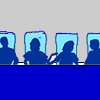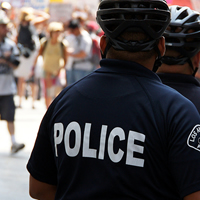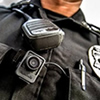Young people are often interested in issues relating to the police, including use-of-force incidents, police treatment of young people in field situations, or accountability in cases of police misconduct. Without a technical knowledge of the law and police practices or lessons that can frame these issues in a non-confrontational way, teachers often feel ill-equipped to approach such subjects. CRF’s Youth & Police curriculum is designed to provide teachers with a resource that can be utilized as an intervention when such incidents arise in their school community.
 Police and the Use of Force
Police and the Use of Force
This lesson focuses on the issue of police use of force in field situations. After a brief focus activity, students read and discuss a reading that describes laws and rules affecting the types and level of force, including deadly force. Then, in a paired activity, students take the role of police officers, review guidelines, and apply them to hypothetical cases.
 Policing the Police
Policing the Police
In this lesson, students focus on issues of police discipline. First, in a reading and discussion, students learn about the processes many police departments use to investigate citizen complaints about misconduct and for disciplining officers. Then, in a simulation activity, students take the role of members of a police Board of Rights to make decisions about a hypothetical case.
 The Case of Special Order 40
The Case of Special Order 40
This lesson features a Panel Discussion activity that provides teachers and students with a format for a structured discussion of controversial immigration policy (Special Order 40, which prohibits LAPD officers from initiating “initiate police action with the objective of discovering the alien status of a person.”).
The Board of Police Commissioners Meeting
Because police enforce the laws, it is sometimes difficult for students to understand that police themselves are subject to various governing bodies. In this two-day lesson, students are introduced to the role of The Board of Police Commissioners (Board) through role-play simulation of an actual Board meeting.
This lesson made possible by funding from the Los Angeles Police Museum.
 Arrest and Search
Arrest and Search
In this lesson, students learn about the law of arrest and search and seizure.
 Police Body Cameras and the Use of Force
Police Body Cameras and the Use of Force
This lesson examines the issue of whether police should wear body cameras to record their interactions with the public. Students learn about policies governing police use of force and the use of body cameras to record related incidents. In a small group activity, students elements of a body camera policy designed for adoption by a local police department.
 Color of Justice
Color of Justice
This reading and activity enable students to examine the issue of racial profiling and its effect on arrests, plea bargaining, jury verdicts, sentencing, and death penalties. Students then form small groups to evaluate the pros and cons of various proposals designed to prevent discrimination in these categories and come up with suggestions of their own.
Peggy York
Teach Democracy dedicates this page to our dearly departed friend and partner and former Los Angeles Police Department Deputy Chief Peggy York. As a board member of the Los Angeles Police Museum (LAPM), Peggy was instrumental in the development of new classroom materials designed to deepen student understanding of their role in improving police-community relations and public safety. Read more about Peggy’s unique legacy and contributions to equitable treatment of women within law enforcement.

